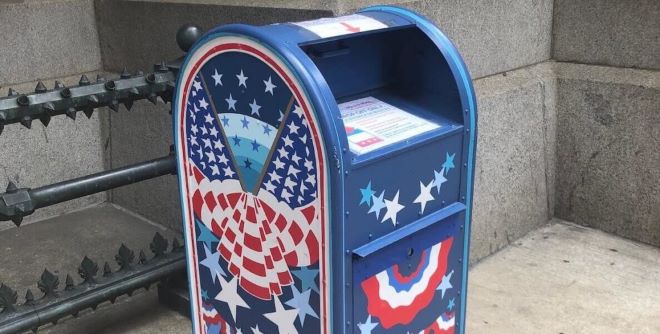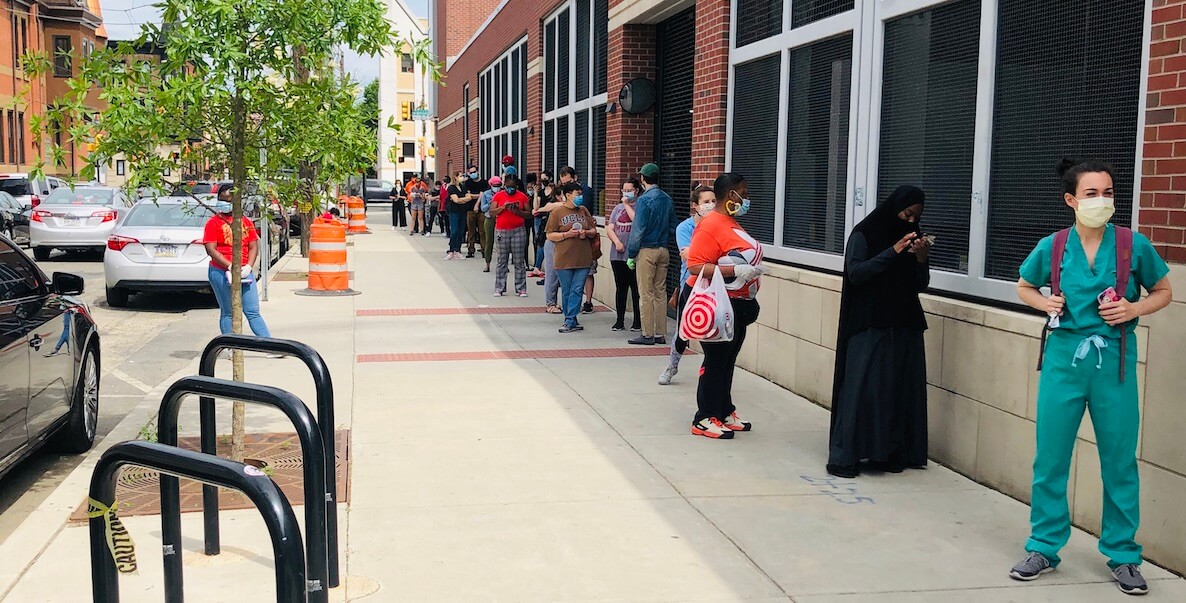Seth Bluestein became one of our City Commissioners — in charge of voting in Philadelphia — when Al Schmidt resigned to lead the Committee of 70. Bluestein entered the role with 10 years of election experience, including as Deputy Commissioner. He’s a lifelong Philadelphian with undergraduate and graduate degrees from the University of Pennsylvania, where, as a student, he worked on political campaigns.
In light of continued disinformation about the integrity of our elections — and the ramping-up race for mayor of Philadelphia — Broad + Liberty sat down with Bluestein explain how elections in Philadelphia work, dispel myths about voting, — and explain why we should have confidence in the system.
This transcript has been condensed and edited. To listen to the full interview on Broad + Liberty, go here.
Preventing counterfeit ballots and such
Todd Shepherd: We’ve noticed both before and after the election, as we saw in mainly Republicans, but also some Democrats, skepticism of the mail-in voting processes. We realized how, oftentimes, these people who had this skepticism, they really just didn’t understand all of the security procedures that were in place. What stops a counterfeit mail-in ballot from being counted?
Seth Bluestein: There are procedures in place, whether it’s for mail-in votes or in-person votes, to prevent widespread fraud and abuse of the system. What we do in the commissioner’s office is build trust in elections. That trust is earned when we pursue any examples of irregularities that may turn out to be fraud, and then have conversations like this.
That being said, there’s a couple ways we make sure ballots can’t just be counterfeited and then counted as additional votes.
First, we use a specific ballot paper stock. So you can’t just go to Kinko’s or Staples and just print off copies of ballots on regular paper. The ballots are designed in a way to be counted by tabulators, and those tabulators are programmed to count the ballots that are on the specific paper stock that is designed in a very specific way. That would very easily be caught, and those ballots wouldn’t be counted.
The other most important aspect of making sure counterfeit ballots aren’t counted is that the ballots are sent out to voters in envelopes that are barcoded for that specific voter. So we know whenever a voter returns a ballot in their envelope that we sent them, and they wouldn’t be able to return a ballot just in any envelope that isn’t one we send out. So there’s no way for additional ballots to be received by us and counted.
When you return a ballot, it must be two things in Pennsylvania: first, inside of the secrecy envelope; and then, that secrecy envelope must be inside of what we call the declaration envelope. That declaration envelope has a barcode on the bottom right corner that identifies the voter for whom the ballot is being returned.
That is the only way that we can receive your ballot. If your ballot is not inside of that declaration envelope, it will not be counted.
Have you ever seen anything that looked like an attempt to counterfeit?
Never. I have seen a few examples of voters who accidentally returned the wrong ballot … There could be a voter who received a mail-in ballot for both the primary and the general, and for some reason chose not to vote. Sometimes we’ll find a primary ballot inside of that voter’s general election envelope. Then, of course, that ballot can’t be counted because it’s for the wrong election.
So even if someone had the skill to counterfeit a barcode for the outer envelope, and assuming they were able to match the paper stock of the ballot …
It’s not even just the voter that the barcode identifies, it identifies the ballot correspondence that we sent that voter. Let’s say a voter was sent a ballot and never received it, and they’re down in Florida voting by absentee, and they need us to send a replacement ballot.
The barcodes are specific to that individual ballot. So, we would know not to count the original ballot, so a voter wouldn’t even be able to return it and have counted two ballots, because we would know which barcode and correspondence to actually count when we receive it. So there’s even another layer there to prevent that type of additional vote.
The big worry is that someone would request a mail-in ballot, receive it, mark it, send it in — and then also go try to vote on Election Day at their precinct or …
The first thing we have to keep in mind is, what is there to gain for an individual to do that?
We’re talking about somebody who is attempting to commit a felony to add one vote. So right off the bat, it’s pretty rare for that even to be something that somebody would attempt. That doesn’t mean it doesn’t happen. In 2020, we saw that in other counties in Pennsylvania. There are a couple examples that the lieutenant governor — when he was Tweeting about the 2020 election constantly — would point out on a regular basis.

But there are safeguards in place at the polling place to prevent that from happening or mitigate against the risk of that happening. There’s a couple steps:
First is, if you apply for a mail-in ballot, the poll book will be marked when it is printed with a watermark that says that you applied for a mail-in ballot. So the poll workers will know that there’s something going on here, and you’re not just a regular in-person vote.
The second step is, if you returned your ballot prior to those poll books being printed, your name is actually removed from the poll book. So you won’t even be in the poll book to be able to sign in.
And, if you returned your ballot after the initial poll books were printed, but prior to the Monday before Election Day, you’d actually be updated in the supplemental poll books, which we send to every single polling place where we give a list of voters and their updates to the poll workers, so they can check that list to see if you ended up returning your ballot.
Then what Philadelphia has done for the past two-and-a-half, three years now, is late arriving ballots — ballots that we received in the last three to five days before Election Day. We check those against the poll book when the poll books come back on election night, and then over the next couple days to verify that those late arriving ballots — those voters also didn’t vote in-person.
If you vote in person on the voting machine, once you cast your vote, they’re anonymized within the voting system, so you can’t unscramble that egg. If an individual were to cast a vote on the voting machine, and then we also had a mail-in ballot or provisional ballot or any type of paper ballot in our processing center, that second ballot wouldn’t be counted.
Counting votes in Philadelphia
What are the concerns that you hear about tabulation? What are the processes that ensure tabulation is happening accurately?
If you put aside the conspiracy theories, there are a lot of voters who have legitimate questions of, I cast my vote, how do I know it was counted properly? That is a question we get all the time.
There are a number of steps we take before and after the election to verify that the votes were counted accurately. The first thing we do is called “logic and accuracy testing.” We do this testing prior to Election Day on every single voting machine and all the tabulators for the mail-in ballots.
We have staff cast test votes and run through a test deck of ballots. Then they verify that the tabulators and the voting machines are accurately tabulating those votes for the expected totals. So the staff will know what the vote total should be during that test, and then they make sure it matches, and it does. Of course, we wouldn’t approve any of the machines to be used if they didn’t pass that test.
After Election Day in Pennsylvania, we do two different types of audits.
The first audit we complete in the election cycle is known as a “risk-limiting audit.” It is something we’ve been able to do since the 2019 general when we first used our new voting machines. What that does is, we take a statistical sample of the ballots, and we verify that the results from that statistical sample are within an accepted margin of error, the expected results from Election Day. So with 99.5 percent confidence, we can say that the winner was actually the winner.
Then the traditional audit is what is called in Pennsylvania a “two percent audit,” which every county does. And it is when you hand-audit either 2,000 ballots or 2 percent of the ballots that are cast, whichever number is lower. In Philadelphia, that means we’re always auditing 2,000 ballots.
By hand, you go through every single vote that was cast on those ballots, and make sure that the audit matches what the tabulator is saying. We do that after every single election to make sure that the votes are being counted accurately.
How does the city convey the results of those audits to the public?
People are used to seeing results on the news or on our website and on election night, just knowing the winner. But those are unofficial tallies that are presented to the public. You actually have a 20-day window of time when votes are counted. And this is true all over the country.
Every state has a canvassing period, and that period includes two weeks of actually counting votes, and then a week in which those results are made public and can be challenged in court or asked for recounts or anything like that. Audits occur during that window of time, and they are open to the credentialed observers who have been at the campus observing the counting of the county unit vote the entire time.
The thing that’s new for this past election is, we had to submit the results of our audit with our certification to the Department of State. And the Department of State is supposed to post on their website, not just the certified results, but also the certified audit of those results.
One of the most charged terms is “ballot harvesting”. How do you define that?
You see that term used in a lot of different ways, and it’s not always used accurately. The first thing to make sure people understand is every state has its own election laws. At the county level where we implement the elections, we have to follow Pennsylvania’s election laws. But other states have different procedures.
In some states, you might be able to collect ballots for your neighbors and turn them in, or maybe only for your household or your spouse. In Pennsylvania, the only people who can turn in somebody else’s ballot is an individual who is a designated agent for somebody who is disabled. A disabled voter can sign an affidavit to allow somebody to turn their ballot in for them, and they can only do so for a single person’s household for that disabled voter.
Ballot harvesting in the sense of a negative connotation would imply somebody’s going around and they’re collecting a ton of ballots from people and they’re turning them in. You just don’t see that very often in Pennsylvania …
What I’ve seen a number of times when we’re at a ballot collection site, or we’re at City Hall: Somebody comes in and tries to turn in both their ballot and their kid’s ballot, or their ballot and their spouse’s ballot. Now, these are legitimate votes. They are registered voters, they are individually signed declaration envelopes from those individual voters.
But we have to turn the second ballot away because you can’t turn in somebody else’s ballot except for that one narrow exception. A drop box has notices on the box making sure that the voters understand what the law is. So it’s giving them a warning, Hey, you can only turn in your own ballot outside of these narrow exceptions.
And the voters, while they’re almost always polite about it, they don’t understand why it is so cumbersome for them to be able to turn in those votes. In theory, they could just go to a mailbox and drop off the mail like they would a bill or anything else that they turn in for their spouse or their family members. So I think there’s definitely a conversation to be had about what exactly are we protecting against, and balancing the interests of the voters who certainly, at least in my experience, feel like the current restrictions are a little bit too tight.
About those drop boxes
Talk about the concerns you’ve seen from people about drop boxes — and how drop boxes actually work.
In Pennsylvania, the ballot must be received by 8pm on Election Day. So there’s no postmarks, there’s no receiving these ballots later in the week other than military.
When you look at the data, the drop boxes become most used and most necessary within the last four days before the election, including Election Day. So that Saturday, Sunday, Monday, Tuesday. What you see is a lot of voters who have received their ballot and they were either waiting to cast their vote or they just received it and they want to get it back to us. So they put it in one of our drop boxes.
Now, what is a drop box? A drop box, functionally, is the same thing as one of those blue mailboxes you see on almost every corner, except, rather than being collected by a postal worker, it’s collected by our staff. We have a chain of custody forms. When an employee goes to a drop box, they sign the form, they take the ballots out, they deliver it to the warehouse, the person receiving it signs the form, and then those ballots are time and date stamped, and they go through the normal process to be counted or rejected depending on the specific details.

The last piece for drop boxes compared to regular mailboxes is the drop boxes are under video surveillance. So, if something were to be suspicious or need to be looked at, we can go through that footage and take a look at what is going on with that particular drop box.
Would it help the public’s confidence if this vote counting agency said, Before we count anything, I’m here to tell you that we have 566,228 total votes cast, and when we total them up, that’s how many votes we’ll have?
One of the new things that counties in Pennsylvania had to do in this election, in most counties — for those who took the election integrity grant from the state legislature — was post an unofficial number of ballots received by midnight on election night. The reason that number is unofficial is because military and overseas voters have an additional week to return their ballots. So there are some ballots that we added to that count. There are also ballots who have not yet verified their identification.
It’ll never be an exact one-to-one because of all these different categories that come up while you’re canvassing the ballots.
It’s very important for voters and for candidates and campaigns and the public at large to have transparency and to understand what their expectations are for how many ballots about approximately there should be, and then how many are getting counted. And we did that this election. And our numbers look very good. They’re very accurate. And part of the reason it takes so long to count votes — in Pennsylvania, at least — is because we don’t have preprocessing or pre-canvass prior to Election Day.
So, we can’t even start opening and reviewing those ballots until 7am. on Election Day. When you’re talking about hundreds of thousands of envelopes and pieces of paper, it takes a lot of time to review all that and to count them accurately.
Final thoughts?
I want to encourage everybody to really, when they’re asking questions, go to the source of where that information is. If you have a question about: How do I know my ballot was counted properly? Or, what about this individual person’s ballot who, you know, they received it, but they haven’t verified their identification yet — how do I know that you’re actually checking their ID to make sure their ballot should be counted?
Asking those questions of a trusted source is really important. Because there’s a lot of misinformation out there. Sometimes it’s well-meaning, and the person just misunderstands the process. Sometimes it’s a little bit more intentional, but regardless, putting out information that isn’t accurate or isn’t taking into account the nuance of how elections are run creates more distrust in the system than the actual procedures.
Having conversations like this is so important to rebuilding the trust in our elections so that everybody, whether it’s Democrats, Republicans or Independents, they all go into an election knowing what the rules of the game are, knowing that there are civil service employees and public servants who are counting those votes. They’re doing their absolute best to count those votes accurately and timely. And then when the results are certified, everyone can have faith in that process and in those results.
That’s what we’ve been working on every single day over our career, is to build that level of trust. So, thank you for having this conversation because it’s just another really important piece of that puzzle.
![]() MORE ELECTION COVERAGE FROM THE CITIZEN
MORE ELECTION COVERAGE FROM THE CITIZEN




